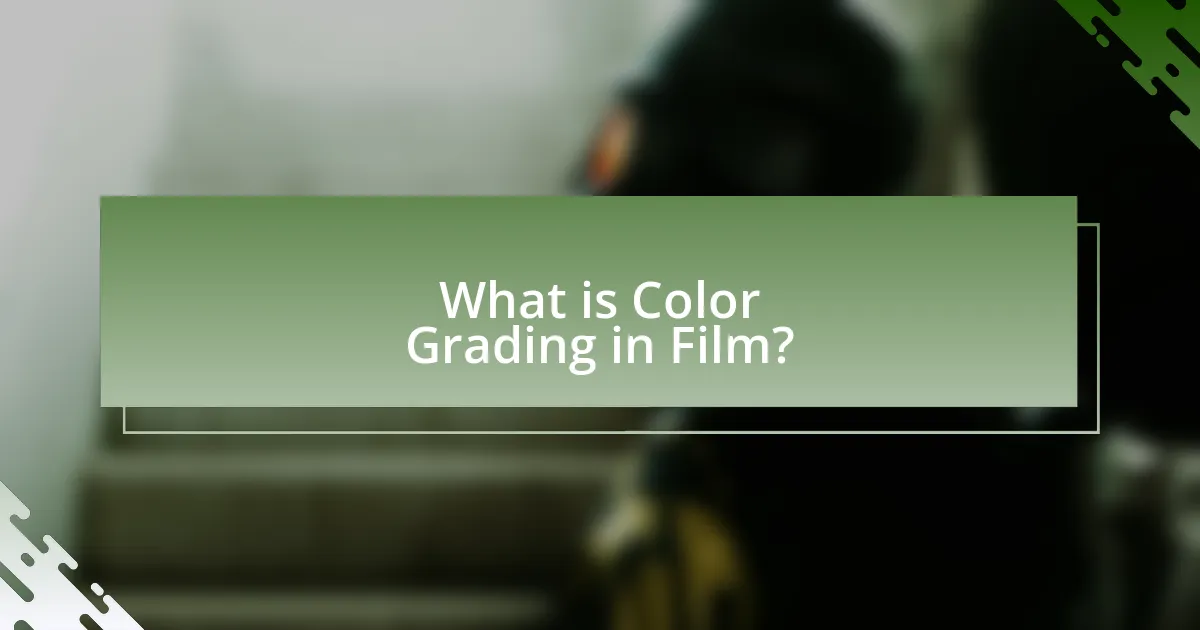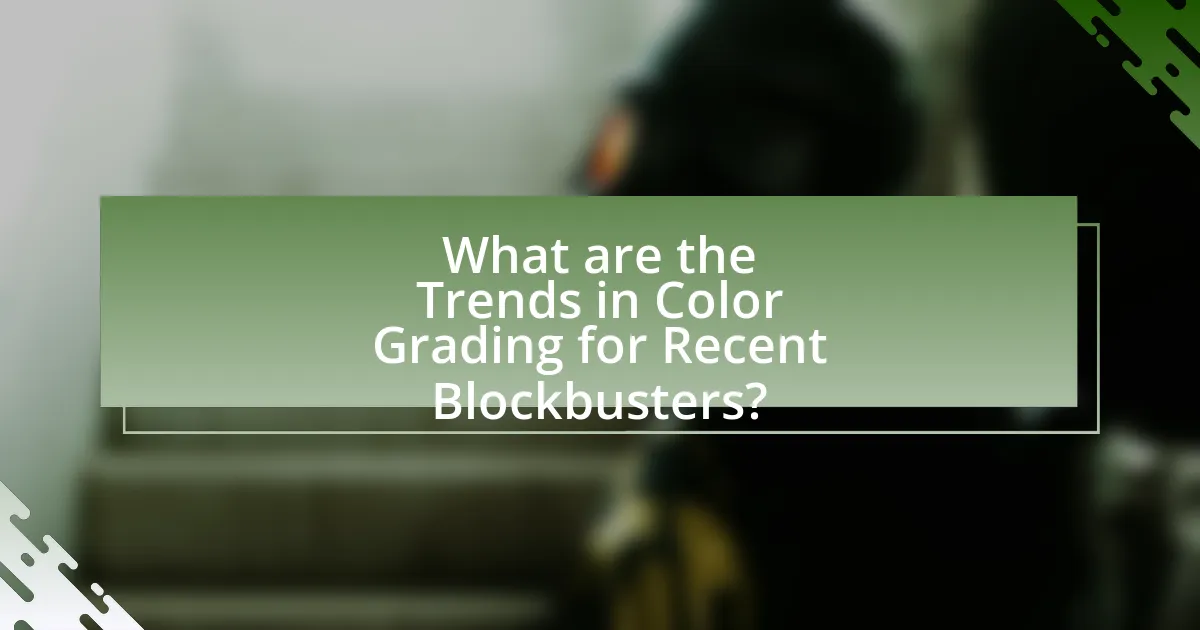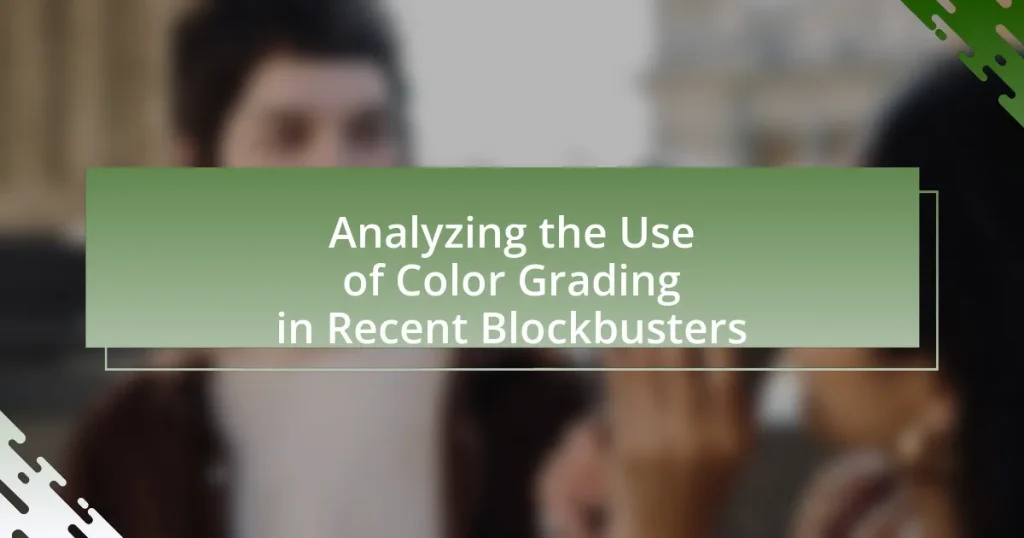The article focuses on the critical role of color grading in recent blockbuster films, examining how this process enhances visual storytelling and influences audience perception. It outlines key techniques such as color correction, enhancement, and stylization, and discusses their impact on mood and emotional response. The article also highlights trends in color grading, technological advancements, and the collaboration between filmmakers and colorists, providing examples from notable films to illustrate effective color grading practices. Additionally, it addresses common challenges and pitfalls in color grading, offering best practices for filmmakers to achieve their desired visual style.

What is Color Grading in Film?
Color grading in film is the process of adjusting the color and tonal qualities of a video to achieve a desired aesthetic or mood. This technique enhances visual storytelling by manipulating elements such as brightness, contrast, saturation, and hue, allowing filmmakers to create a specific atmosphere or emotional response. For instance, films like “Mad Max: Fury Road” utilize vibrant color grading to emphasize the desolate landscape, while “The Matrix” employs a green tint to evoke a sense of artificiality. These choices are integral to the film’s narrative and visual identity, demonstrating the significant impact of color grading on audience perception and engagement.
How does color grading influence the visual storytelling of a film?
Color grading significantly influences the visual storytelling of a film by enhancing mood, establishing tone, and guiding audience perception. For instance, warm color palettes can evoke feelings of comfort or nostalgia, while cooler tones may create a sense of detachment or tension. Research indicates that color grading can affect emotional responses; a study published in the Journal of Media Psychology found that specific color schemes can elicit distinct emotional reactions, thereby impacting viewer engagement and interpretation of narrative elements. This demonstrates that effective color grading not only beautifies a film but also serves as a crucial tool for conveying themes and character arcs, ultimately shaping the audience’s understanding of the story.
What are the key techniques used in color grading?
The key techniques used in color grading include color correction, color enhancement, and color stylization. Color correction adjusts the overall color balance and exposure to achieve a natural look, ensuring consistency across shots. Color enhancement involves boosting specific colors to create a more vibrant image, often used to evoke emotions or highlight elements within a scene. Color stylization applies creative color palettes and effects to establish a specific mood or aesthetic, frequently seen in genres like fantasy or horror. These techniques are essential for achieving the desired visual impact in films, as evidenced by their widespread application in recent blockbusters, where they contribute significantly to storytelling and audience engagement.
How does color grading affect audience perception and emotion?
Color grading significantly influences audience perception and emotion by altering the visual tone and mood of a film. This technique manipulates colors to evoke specific feelings; for instance, warmer tones can create a sense of comfort or nostalgia, while cooler tones may evoke sadness or tension. Research indicates that color can affect psychological responses; a study published in the journal “Color Research and Application” found that colors like red can increase arousal and excitement, while blue can promote calmness. Thus, filmmakers strategically use color grading to guide audience emotions and enhance storytelling, making it a crucial element in cinematic experiences.
Why is color grading important in recent blockbusters?
Color grading is important in recent blockbusters because it enhances visual storytelling by establishing mood, tone, and atmosphere. This process allows filmmakers to manipulate colors to evoke specific emotional responses from the audience, thereby deepening engagement with the narrative. For instance, films like “Mad Max: Fury Road” utilized a distinct color palette to create a post-apocalyptic feel, which contributed to its critical acclaim and box office success. Additionally, studies have shown that color grading can significantly influence audience perception and memory retention, making it a crucial element in modern cinematic techniques.
What role does color grading play in establishing a film’s tone?
Color grading plays a crucial role in establishing a film’s tone by manipulating the color palette to evoke specific emotions and atmospheres. For instance, warm tones can create a sense of comfort or nostalgia, while cooler tones often convey tension or sadness. Research indicates that color grading influences audience perception; a study published in the Journal of Media Psychology found that color choices significantly affect emotional responses to visual media. This demonstrates that effective color grading not only enhances visual storytelling but also shapes the overall mood and emotional impact of a film.
How does color grading enhance the overall cinematic experience?
Color grading enhances the overall cinematic experience by manipulating the visual tone and mood of a film, thereby influencing audience emotions and perceptions. This process involves adjusting the colors, contrast, and brightness to create a specific atmosphere that aligns with the narrative. For instance, films like “Mad Max: Fury Road” utilize vibrant color palettes to evoke a sense of chaos and intensity, while “The Revenant” employs muted tones to convey bleakness and survival. Research indicates that color grading can significantly affect viewer engagement and emotional response, as evidenced by studies showing that color can evoke specific feelings, such as warmth or coldness, which directly impacts how a story is perceived.

What are the Trends in Color Grading for Recent Blockbusters?
Recent blockbusters exhibit trends in color grading that emphasize a cinematic aesthetic, often characterized by high contrast, desaturated colors, and a focus on mood enhancement. For instance, films like “Dune” utilize a muted color palette to evoke a sense of otherworldliness, while “The Batman” employs dark, moody tones to create a gritty atmosphere. These choices reflect a broader industry shift towards stylized visuals that support narrative themes, as evidenced by the increasing use of color grading software like DaVinci Resolve, which allows for precise manipulation of hues and tones. This trend is further supported by audience preferences for visually striking content, as seen in box office successes that prioritize unique visual storytelling.
How have color grading techniques evolved in the last decade?
Color grading techniques have significantly evolved in the last decade, primarily due to advancements in digital technology and software. The introduction of high dynamic range (HDR) imaging has allowed for a broader color spectrum and enhanced contrast, enabling filmmakers to create more visually striking images. Additionally, the rise of machine learning and artificial intelligence in color grading software has streamlined the process, allowing for faster adjustments and more precise color matching. For instance, tools like DaVinci Resolve have integrated AI features that assist in automatic color correction, which has become increasingly popular among professionals. These advancements have not only improved the efficiency of color grading but also expanded creative possibilities, allowing filmmakers to achieve unique visual styles that were previously difficult to realize.
What are the most popular color palettes used in recent films?
The most popular color palettes used in recent films include vibrant and saturated hues, muted tones, and monochromatic schemes. Films like “Mad Max: Fury Road” utilize high-contrast, saturated colors to create a striking visual impact, while “The Revenant” employs a more muted, earthy palette to enhance its naturalistic storytelling. Additionally, the use of monochromatic color schemes, as seen in “The Lighthouse,” emphasizes mood and atmosphere. These choices reflect trends in color grading that aim to evoke specific emotions and enhance narrative themes, supported by the increasing use of digital color grading technology in filmmaking.
How do filmmakers choose color grading styles for different genres?
Filmmakers choose color grading styles for different genres based on the emotional tone and visual storytelling requirements of each genre. For instance, horror films often utilize desaturated colors and high contrast to create a sense of unease, while romantic comedies typically employ warm, vibrant hues to evoke feelings of joy and intimacy. Research indicates that color psychology plays a significant role in audience perception, influencing how viewers emotionally connect with the narrative. Studies have shown that specific color palettes can enhance genre conventions; for example, the use of blue tones in science fiction films can suggest a futuristic or otherworldly atmosphere, as seen in films like “Blade Runner 2049.” Thus, filmmakers strategically select color grading to align with genre expectations and enhance the overall viewer experience.
What technological advancements have impacted color grading?
Technological advancements that have impacted color grading include the development of digital color grading software, high dynamic range (HDR) imaging, and advancements in camera technology. Digital color grading software, such as DaVinci Resolve and Adobe Premiere Pro, allows for precise manipulation of color and light, enabling filmmakers to achieve specific visual styles. High dynamic range imaging enhances the range of colors and brightness levels captured, providing more detail in highlights and shadows, which is crucial for modern cinematic visuals. Additionally, advancements in camera technology, including sensors with greater color accuracy and wider color gamuts, have improved the quality of footage available for color grading, allowing for more creative possibilities in post-production. These advancements collectively enhance the visual storytelling capabilities in recent blockbusters.
How has software development changed the color grading process?
Software development has significantly transformed the color grading process by introducing advanced software tools that enhance precision and efficiency. Modern color grading software, such as DaVinci Resolve and Adobe Premiere Pro, allows for real-time adjustments, enabling colorists to see changes instantly and make more informed decisions. Additionally, the integration of machine learning algorithms has automated various aspects of color correction, improving consistency and reducing the time required for manual adjustments. For instance, AI-driven features can analyze footage and suggest optimal color settings based on the content, which streamlines the workflow and enhances creative possibilities. These advancements have made high-quality color grading more accessible to filmmakers, contributing to the visual richness seen in recent blockbusters.
What role do digital cinema cameras play in color grading?
Digital cinema cameras are crucial in color grading as they capture high dynamic range (HDR) images and wide color gamuts, which provide extensive data for post-production adjustments. This capability allows colorists to manipulate colors, contrast, and brightness with greater precision, enhancing the visual storytelling of films. For instance, cameras like the ARRI Alexa and RED Komodo are designed to retain more detail in shadows and highlights, enabling a more nuanced color grading process that aligns with the director’s vision. The use of these advanced cameras directly influences the final aesthetic of blockbusters, as evidenced by films that utilize their capabilities to create distinct visual styles.

How is Color Grading Applied in Specific Recent Blockbusters?
Color grading in specific recent blockbusters is applied to enhance visual storytelling and establish mood. For instance, in “Dune,” the color palette emphasizes the harshness of the desert environment through warm tones, while cooler shades are used in scenes depicting the futuristic technology, creating a stark contrast that supports the narrative. Similarly, “The Batman” employs a dark, desaturated color scheme to evoke a gritty atmosphere, aligning with the film’s themes of crime and moral ambiguity. These choices are not arbitrary; they are meticulously crafted to resonate with the audience’s emotional experience, demonstrating the critical role of color grading in modern cinema.
What are some notable examples of effective color grading in recent films?
Notable examples of effective color grading in recent films include “Dune,” “The Matrix Resurrections,” and “The French Dispatch.” In “Dune,” the color grading enhances the stark contrasts between the desert landscapes and the characters, using a palette that emphasizes the harshness of the environment. “The Matrix Resurrections” employs a distinctive green tint to evoke the original film’s aesthetic while modernizing it, creating a visual continuity that resonates with audiences. “The French Dispatch” utilizes vibrant colors to reflect the whimsical nature of its storytelling, with each segment featuring a unique color scheme that complements its narrative style. These films demonstrate how color grading can significantly impact the visual storytelling and emotional resonance of a film.
How does the color grading in “Film A” contribute to its narrative?
The color grading in “Film A” enhances its narrative by establishing mood and emphasizing character development. For instance, the use of warm tones during intimate scenes fosters a sense of connection, while cooler hues in tense moments create a feeling of isolation. This strategic application of color not only reflects the emotional states of the characters but also guides the audience’s perception of the story’s progression. Studies have shown that color can significantly influence viewer emotions, reinforcing the idea that the color grading in “Film A” is integral to its storytelling.
What unique color grading choices were made in “Film B” and why?
“Film B” utilized a desaturated color palette with high contrast to evoke a sense of realism and emotional intensity. This choice aimed to enhance the film’s dramatic themes and create a more immersive experience for the audience. The desaturation allows the viewer to focus on character emotions and narrative depth, while the high contrast emphasizes key moments, drawing attention to pivotal scenes. This approach aligns with contemporary trends in color grading that prioritize emotional resonance over vibrant aesthetics, as seen in other successful blockbusters.
What challenges do filmmakers face with color grading?
Filmmakers face several challenges with color grading, including achieving consistency across different scenes, managing the technical limitations of various display devices, and balancing artistic vision with audience expectations. Consistency is crucial as variations in lighting and camera settings can lead to discrepancies in color, making it difficult to maintain a cohesive look throughout the film. Technical limitations arise because colors may appear differently on various screens, such as televisions, projectors, or streaming platforms, which can affect how the final product is perceived. Additionally, filmmakers must navigate the challenge of aligning their creative intentions with the preferences of their target audience, as certain color palettes may resonate differently with viewers. These challenges highlight the complexity of color grading as an essential aspect of filmmaking.
How can inconsistent color grading affect a film’s reception?
Inconsistent color grading can negatively impact a film’s reception by disrupting the visual coherence and emotional tone intended by the filmmakers. When color grading varies significantly throughout a film, it can confuse audiences, detracting from their immersion and emotional engagement. For instance, a study by the American Film Institute found that films with consistent color palettes tend to receive higher viewer ratings, as they create a unified aesthetic that enhances storytelling. This evidence illustrates that inconsistency in color grading can lead to a fragmented viewing experience, ultimately resulting in lower audience satisfaction and critical acclaim.
What are common pitfalls in color grading that filmmakers should avoid?
Common pitfalls in color grading that filmmakers should avoid include over-saturation, inconsistent color palettes, and neglecting the emotional context of scenes. Over-saturation can lead to unnatural visuals, detracting from the story’s authenticity, as seen in films where vibrant colors overshadow character development. Inconsistent color palettes can confuse audiences, disrupting the visual narrative; for example, a film that shifts drastically in color tone can create a jarring viewing experience. Additionally, neglecting the emotional context can result in color choices that fail to enhance the intended mood, undermining the film’s impact. These pitfalls can significantly diminish the overall quality and coherence of a film’s visual storytelling.
What best practices should filmmakers follow for effective color grading?
Filmmakers should follow several best practices for effective color grading, including establishing a clear color palette, using reference images, and ensuring consistency across shots. Establishing a clear color palette helps convey the film’s mood and themes, while reference images provide a benchmark for achieving desired looks. Consistency across shots is crucial to maintain visual coherence, as discrepancies can distract viewers. Additionally, utilizing color grading software effectively allows for precise adjustments, enhancing the overall quality of the film. These practices are supported by industry standards, which emphasize the importance of color in storytelling and audience engagement.
How can collaboration between colorists and directors enhance the process?
Collaboration between colorists and directors enhances the filmmaking process by ensuring a cohesive visual narrative that aligns with the director’s artistic vision. This partnership allows for real-time adjustments during color grading, enabling colorists to apply specific tones and moods that reflect the director’s intent. For instance, in films like “Mad Max: Fury Road,” the collaboration between director George Miller and colorist Eric Whipp resulted in a distinct color palette that amplified the film’s post-apocalyptic atmosphere, demonstrating how effective teamwork can elevate storytelling through visual aesthetics.
What tips can filmmakers use to achieve their desired visual style through color grading?
Filmmakers can achieve their desired visual style through color grading by utilizing a combination of color theory, consistent color palettes, and targeted adjustments to contrast and saturation. Understanding color theory allows filmmakers to evoke specific emotions; for example, warm tones can create a sense of comfort, while cool tones may convey tension. Consistent color palettes throughout a film help maintain visual coherence, enhancing storytelling. Additionally, adjusting contrast and saturation can emphasize key elements in a scene, guiding the audience’s focus. These techniques are supported by industry practices, as seen in films like “Mad Max: Fury Road,” where color grading played a crucial role in establishing the film’s unique aesthetic and emotional impact.




